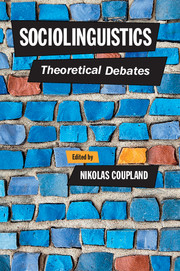Book contents
- Frontmatter
- Contents
- List of contributors
- Preface and acknowledgements
- 1 Introduction: Sociolinguistic theory and the practice of sociolinguistics
- Part I Theorising social meaning
- Part II Language, markets and materiality
- Part III Sociolinguistics, place and mobility
- Part IV Power, mediation and critical sociolinguistics
- Part V Sociolinguistics, contexts and impact
- Part VI The evolution of sociolinguistic theory
- Index
- References
1 - Introduction: Sociolinguistic theory and the practice of sociolinguistics
Published online by Cambridge University Press: 05 June 2016
- Frontmatter
- Contents
- List of contributors
- Preface and acknowledgements
- 1 Introduction: Sociolinguistic theory and the practice of sociolinguistics
- Part I Theorising social meaning
- Part II Language, markets and materiality
- Part III Sociolinguistics, place and mobility
- Part IV Power, mediation and critical sociolinguistics
- Part V Sociolinguistics, contexts and impact
- Part VI The evolution of sociolinguistic theory
- Index
- References
Summary
Theory and practice
Theory and practice are terms that are often set in opposition to each other, but not for very good reasons. This is a book about theory, but it is not a book that is, one might say, ‘couched in abstractions with little relevance to the real world of language use’. Who needs theory, if that's what theory is? On the contrary, theory is about what we see and experience in the social world of language, and about how we impute meaning to actions. As language users, we are all theorists, although the discipline of sociolinguistics has particular responsibilities in fostering, through its theory, awareness of what happens at the interface between language and society, and in reviewing what we know and what we have not yet adequately explained. So this is actually a book about practice too – practices of using language and practices of interpreting language in society.
My main task in the chapter is to set the scene for the nineteen chapters that follow; I introduce the chapters and the structure of the volume in the second half of this chapter. Before that it may be useful to comment in quite general terms on ‘theory’, and then on ‘sociolinguistic theory’, the object of debate in this volume, and its historical status in the field. That will lead to an overview of the types of theory that sociolinguistics has aligned with to date, and might profitably align with in the future. This is a necessary debate in itself, especially if it is right to observe that sociolinguistics has entered a phase where ‘theory is everywhere’ and that this is radically influencing what sociolinguistics is and what it does. But we are also arguably in a phase where discussion of what counts as theory, and why it matters in so many practical regards, is still generally lacking. In other words, we need to keep revisiting some basic metatheoretical questions about sociolinguistics, following a line of reflexive commentary started by Figueroa over twenty years ago. Figueroa (1994) set out the different principles and assumptions that supported the research of three of the ‘founding fathers’ of sociolinguistics, Labov, Gumperz, and Hymes.
- Type
- Chapter
- Information
- SociolinguisticsTheoretical Debates, pp. 1 - 34Publisher: Cambridge University PressPrint publication year: 2016
References
- 10
- Cited by



